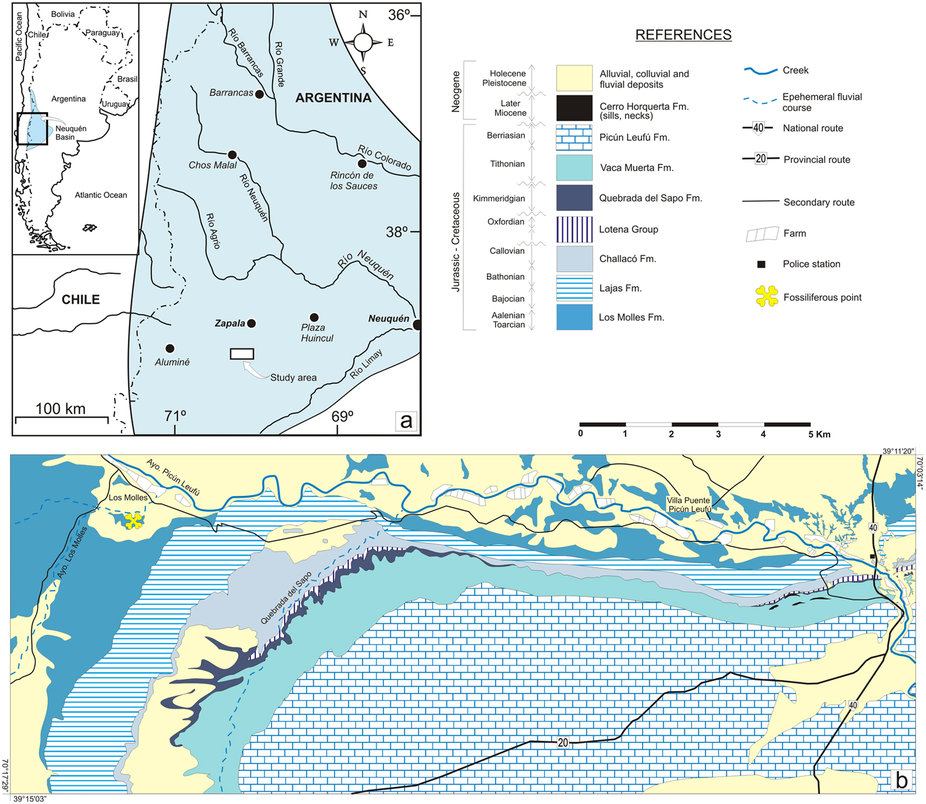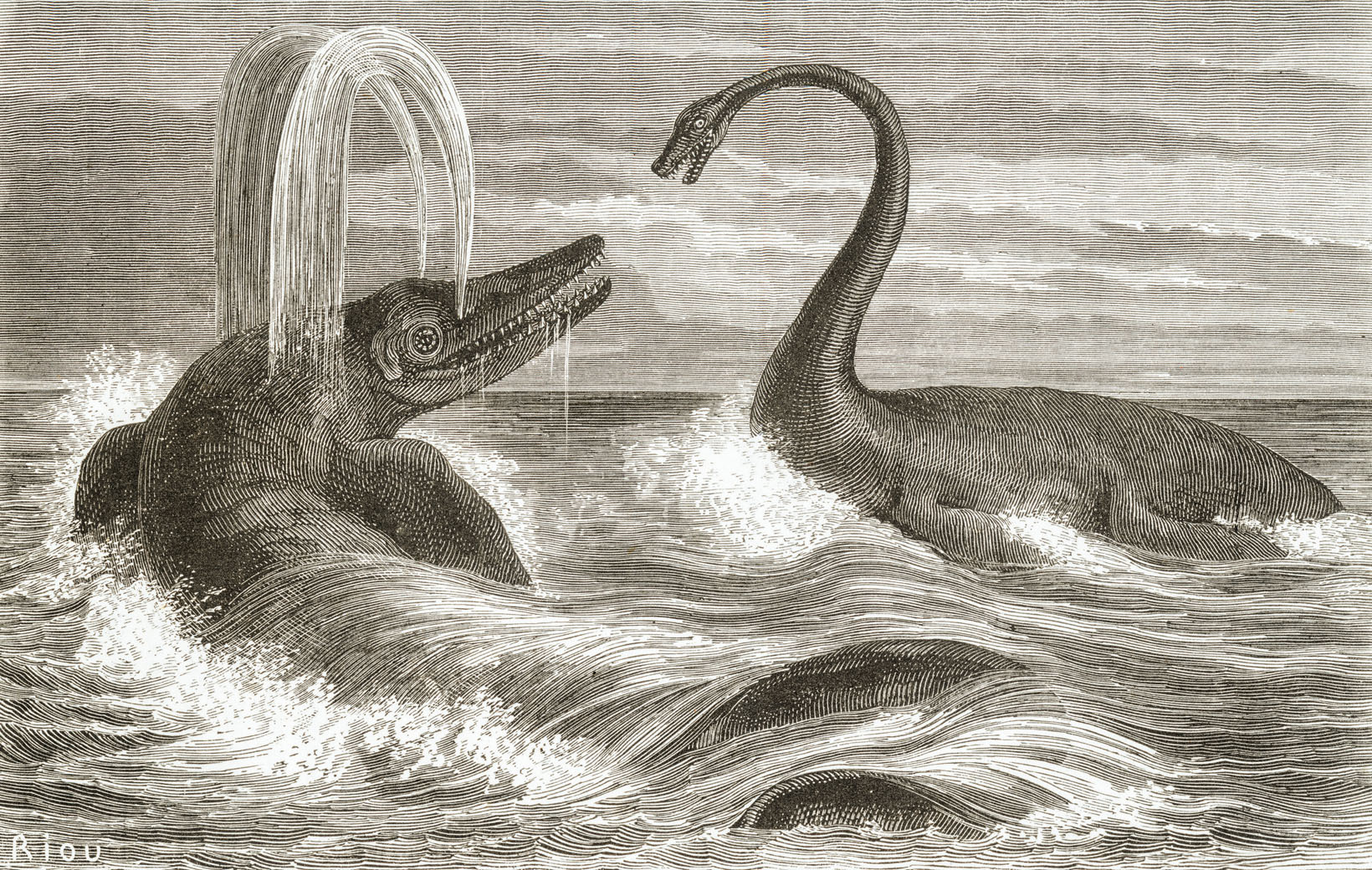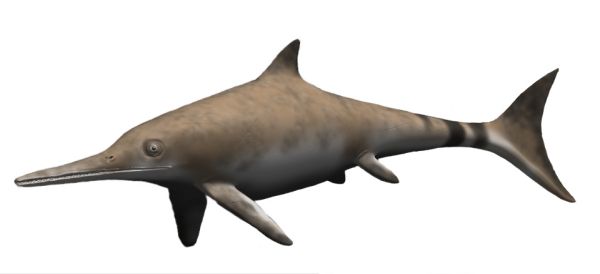|
Mollesaurus
''Mollesaurus'' is an extinct genus of large ophthalmosaurine ophthalmosaurid ichthyosaur known from northwestern Patagonia of Argentina. Etymology ''Mollesaurus'' was named by Marta S. Fernández in 1999 and the type species is ''Mollesaurus periallus''. The generic name is derived from the name of the Los Molles Formation, where the holotype was collected, and ''sauros'', Greek for "lizard". The specific name is derived from ''periallos'', Greek for "before all others", in reference to the fact that it is the oldest ophthalmosaurid and one of the oldest thunnosaurs. History of study ''Mollesaurus'' is known from the holotype MOZ 2282 V, articulated partial skeleton which preserved partial skull and most of the vertebral column. It was collected in the Chacaico Sur locality from the ''Emileia giebeli'' ammonoid zone of the Los Molles Formation, Cuyo Group, dating to the early Bajocian stage of the Middle Jurassic, about 171.6-170 million years ago. ''Mollesau ... [...More Info...] [...Related Items...] OR: [Wikipedia] [Google] [Baidu] |
Ophthalmosaurid
Ophthalmosauridae is an extinct family of thunnosaur ichthyosaurs from the Middle Jurassic to the early Late Cretaceous (Bajocian - Cenomanian) worldwide. Almost all ichthyosaurs from the Middle Jurassic onwards belong to the family, until the extinction of ichthyosaurs in the early Late Cretaceous. Opthalmosaurids appeared worldwide during early Bajocian, subsequent to the disappearance of most other ichthyosaur lineages after the end of the Toarcian. Currently, the oldest known ophthalmosaurids is '' Mollesaurus'' from the early Bajocian of Argentina, as well as indeterminate remains of the same age from Luxembourg and Canada. Named by George H. Baur, in 1887, the family contains the basal taxa like ''Ophthalmosaurus''. Appleby (1956) named the taxon Ophthalmosauria which was followed by some authors, but these two names are often treated as synonyms; Ophthalmosauridae has the priority over Ophthalmosauria. However, some researchers argue that Ophthalmosauridae should be restric ... [...More Info...] [...Related Items...] OR: [Wikipedia] [Google] [Baidu] |
Ophthalmosaurus
''Ophthalmosaurus'' (meaning "eye lizard" in Greek) is an ichthyosaur of the Jurassic period (165–150 million years ago). Possible remains from the Cretaceous, around 145 million years ago, are also known. It was a relatively medium-sized ichthyosaur, measuring long and weighing . Named for its extremely large eyes, it had a jaw containing many small but robust teeth. Major fossil finds of this genus have been recorded in Europe with a second species possibly being found in North America. Description ''Ophthalmosaurus'' was a medium-sized ichthyosaur, measuring long and weighing . It had a robust, streamlined body that was nearly as wide as it was tall in frontal view. Like other derived ichthyosaurs ''Ophthalmosaurus'' had a powerful tail ending in a pronounced bi-lobed caudal fluke whose lower half was formed around the caudal spine whereas the upper lobe was made up entirely from soft tissue. The limbs of ''Ophthalmosaurus'' were short and rounded with the forelimbs bein ... [...More Info...] [...Related Items...] OR: [Wikipedia] [Google] [Baidu] |
Chacaicosaurus
''Chacaicosaurus'' is a genus of neoichthyosaurian ichthyosaur known from the Middle Jurassic of Argentina. The single known specimen of this genus was excavated from the Los Molles Formation in Neuquén Province, and is housed at the Museo Olsacher under the specimen number MOZ 5803. This specimen consists of a skull, forelimb, some vertebrae, and some additional postcranial elements. The genus was named by Marta Fernández in 1994, and contains a single species, ''Chacaicosaurus cayi'', making it the first named distinctive ichthyosaur from the Bajocian stage. It is a medium-sized ichthyosaur with a very long snout, which bears a ridge running along each side. The forelimbs of ''Chacaicosaurus'' are small and contain four main digits. Different authors have classified ''Chacaicosaurus'' in different ways; some consider it a thunnosaur closely related to the ophthalmosaurids, others instead place it outside of Thunnosauria, often near ''Hauffiopteryx''. However, as it is very ... [...More Info...] [...Related Items...] OR: [Wikipedia] [Google] [Baidu] |
Ophthalmosaurine
Ophthalmosaurinae is an extinct subfamily of ophthalmosaurid thunnosaur ichthyosaurs from the Middle Jurassic to the late Early Cretaceous (Bajocian - Albian) of Europe, North America and South America. Currently, the oldest and the basalmost known ophthalmosaurine is ''Mollesaurus'' from the early Bajocian of Argentina. Ophthalmosaurines were characterized by a large extracondylar area of the basioccipital in the form of a thick and concave peripheral band, posterodistally deflected ulnar facet of the humerus, large ulna with concave and edgy posterior surface and ischiopubis with obturator foramen. Phylogeny Ophthalmosaurinae was named in 1887 by George H. Baur. It is a stem-based taxon defined phylogenetically for the first time by Fischer ''et al.'' (2012) as "all taxa closer to ''Ophthalmosaurus icenicus'' than to ''Platypterygius hercynicus''". The cladogram A cladogram (from Greek ''clados'' "branch" and ''gramma'' "character") is a diagram used in cladistics to ... [...More Info...] [...Related Items...] OR: [Wikipedia] [Google] [Baidu] |
Caypullisaurus
''Caypullisaurus'' is an extinct genus of platypterygiine ophthalmosaurid ichthyosaur from the Late Jurassic to the Early Cretaceous (Tithonian and Berriasian stages) of Argentina. Its holotype was collected from the Vaca Muerta Formation of Cerro Lotena, Neuquen, dating to the early Tithonian stage of the Late Jurassic, about 150 million years ago. ''Caypullisaurus'' was first named by Marta Fernández in 1997 and the type species is ''Caypullisaurus bonapartei''. It was a large ichthyosaur, measuring about long. Classification It is a member of the family Ophthalmosauridae, and closely related to ''Platypterygius'' and ''Brachypterygius''.Fernández M. 2007. Redescription and phylogenetic position of ''Caypullisaurus'' (Ichthyosauria: Ophthalmosauridae). ''Journal of Paleontology'' 81 (2): 368-375. In 2012, ''Caypullisaurus'' was found to be most closely related to '' Athabascasaurus'' and "''Platypterygius''" ''australis'', and to nest within the subfamily Platypterygiinae ... [...More Info...] [...Related Items...] OR: [Wikipedia] [Google] [Baidu] |
Brachypterygius
''Brachypterygius'' (meaning ″short wing/paddle″ in Greek) is an extinct genus of platypterygiine ophthalmosaurid ichthyosaur known from the Late Jurassic of England.McGowan, C. & Motani, R. ''Ichthyopterygia''. In Sues, H.-D. (ed.) Handbook of Paleoherpetology, vol. 8. Verlag Dr. Friedrich Pfeil, Munich, 175 pp., 19 pls. The type species was originally described and named as ''Ichthyosaurus extremus'' by Boulenger in 1904.Boulenger, G. A. 1904. Exhibition of, and remarks upon, a paddle of a new species of ichthyosaur. ''Proceedings of the Zoological Society of London'', 1904, 424–426. ''Brachypterygius'' was named by Huene in 1922 for the width and shortness of the forepaddle, and the type species is therefore ''Brachypterygius extremus''.Huene, F. F. von 1922. ''Die Ichthyosaurier des Lias und ihre Zusammenhänge''. Verlag von Gebrüder Borntraeger, Berlin, 114 pp., 22 pls. The holotype of ''B. extremus'' was originally thought to be from the Lias Group of Bath, United Ki ... [...More Info...] [...Related Items...] OR: [Wikipedia] [Google] [Baidu] |
Los Molles Formation
The Los Molles Formation is a geologic formation of Early to Middle Jurassic age, located at northern and central part of Neuquén Basin at Mendoza Shelf in Argentina. It is overlain by the Niyeu–Lajas Formation.McIlroy et al., 2005 Description It is the second largest oil and gas formation in the Neuquén Basin after the Vaca Muerta. Los Molles Formation is estimated to have of technically recoverable shale gas and of technically recoverable oil.EIA, 2013 In July 2015, the ''Buenos Aires Herald'' indicated that Pan American Energy and YPF planned to drill 46 shale gas wells in Los Molles over the next four years in their Lindero Atravesado drilling block, at an estimated cost of US$590 million. Fossil content In several outcrops, the Los Molles formation has been the site of paleontological discoveries: the ichthyosaurs ''Chacaicosaurus'' and '' Mollesaurus'', and, in 2017, an ornithischian, ''Isaberrysaura'', discovered with fossilized contents of the gut.Salgado ... [...More Info...] [...Related Items...] OR: [Wikipedia] [Google] [Baidu] |
Ichthyosaur
Ichthyosaurs (Ancient Greek for "fish lizard" – and ) are large extinct marine reptiles. Ichthyosaurs belong to the order known as Ichthyosauria or Ichthyopterygia ('fish flippers' – a designation introduced by Sir Richard Owen in 1842, although the term is now used more for the parent clade of the Ichthyosauria). Ichthyosaurs thrived during much of the Mesozoic era; based on fossil evidence, they first appeared around 250 million years ago ( Ma) and at least one species survived until about 90 million years ago, into the Late Cretaceous. During the Early Triassic epoch, ichthyosaurs and other ichthyosauromorphs evolved from a group of unidentified land reptiles that returned to the sea, in a development similar to how the mammalian land-dwelling ancestors of modern-day dolphins and whales returned to the sea millions of years later, which they gradually came to resemble in a case of convergent evolution. Ichthyosaurs were particularly abundant in the Late Triassic ... [...More Info...] [...Related Items...] OR: [Wikipedia] [Google] [Baidu] |
Patagonia
Patagonia () refers to a geographical region that encompasses the southern end of South America, governed by Argentina and Chile. The region comprises the southern section of the Andes Mountains with lakes, fjords, temperate rainforests, and glaciers in the west and deserts, tablelands and steppes to the east. Patagonia is bounded by the Pacific Ocean on the west, the Atlantic Ocean to the east, and many bodies of water that connect them, such as the Strait of Magellan, the Beagle Channel, and the Drake Passage to the south. The Colorado and Barrancas rivers, which run from the Andes to the Atlantic, are commonly considered the northern limit of Argentine Patagonia. The archipelago of Tierra del Fuego is sometimes included as part of Patagonia. Most geographers and historians locate the northern limit of Chilean Patagonia at Huincul Fault, in Araucanía Region.Manuel Enrique Schilling; Richard WalterCarlson; AndrésTassara; Rommulo Vieira Conceição; Gustavo Walter B ... [...More Info...] [...Related Items...] OR: [Wikipedia] [Google] [Baidu] |
Thunnosaur
Thunnosauria (Greek for "tuna lizard" – ''thunnos'' meaning "tuna" and ''sauros'' meaning "lizard") is an extinct clade of parvipelvian ichthyosaurs from the Early Jurassic to the early Late Cretaceous (Hettangian– Cenomanian) of Asia, Australia, Europe, North America, and South America. Named by Ryosuke Motani in 1999, it contains the basal taxa ''Ichthyosaurus'' and ''Stenopterygius'' and the family Ophthalmosauridae. In thunnosaurs, the fore fin is at least twice as long as the hind fin. Phylogeny Thunnosauria is a node-based taxon defined in 1999 as "the last common ancestor of ''Ichthyosaurus communis'' and ''Stenopterygius quadriscissus'' and all of its descendants". The cladogram A cladogram (from Greek ''clados'' "branch" and ''gramma'' "character") is a diagram used in cladistics to show relations among organisms. A cladogram is not, however, an evolutionary tree because it does not show how ancestors are related to ... below follows the topology from a ... [...More Info...] [...Related Items...] OR: [Wikipedia] [Google] [Baidu] |
Bajocian
In the geologic timescale The geologic time scale, or geological time scale, (GTS) is a representation of time based on the rock record of Earth. It is a system of chronological dating that uses chronostratigraphy (the process of relating strata to time) and geoch ..., the Bajocian is an age (geology), age and stage (stratigraphy), stage in the Middle Jurassic. It lasted from approximately 170.3 annum, Ma to around 168.3 Ma (million years ago). The Bajocian Age succeeds the Aalenian Age and precedes the Bathonian Age. Stratigraphic definitions The Bajocian Stage takes its name from the Latin name (Bajocae) of the town of Bayeux, in the region of Normandy in France. The stage was named and introduced in scientific literature by French palaeontologist Alcide d'Orbigny in 1842. The base of the Bajocian stage is defined as the place in the stratigraphic column where fossils of the ammonite genus ''Hyperlioceras'' first appear. A global reference profile (a GSSP) for the ba ... [...More Info...] [...Related Items...] OR: [Wikipedia] [Google] [Baidu] |
Mya (unit)
Mya may refer to: Brands and product names * Mya (program), an intelligent personal assistant created by Motorola * Mya (TV channel), an Italian Television channel * Midwest Young Artists, a comprehensive youth music program Codes * Burmese language, ISO 639-3 code is * Moruya Airport's IATA code * The IOC, license plate, and UNDP country code for Myanmar Myanmar, ; UK pronunciations: US pronunciations incl. . Note: Wikipedia's IPA conventions require indicating /r/ even in British English although only some British English speakers pronounce r at the end of syllables. As John Wells explai ... ("MYA") People * Mya (given name) * Mya (singer) (Mya Marie Harrison, born 1979), an American R&B singer-songwriter and actress * Bo Mya (1927–2006), nom de guerre of a Myanmar rebel leader, chief rapist of the Karen National Union Other uses * ''Mýa'' (album), a 1998 album by Mýa * ''Mya'' (bivalve), a genus of soft-shell clams * MYA (unit) for "million ... [...More Info...] [...Related Items...] OR: [Wikipedia] [Google] [Baidu] |




